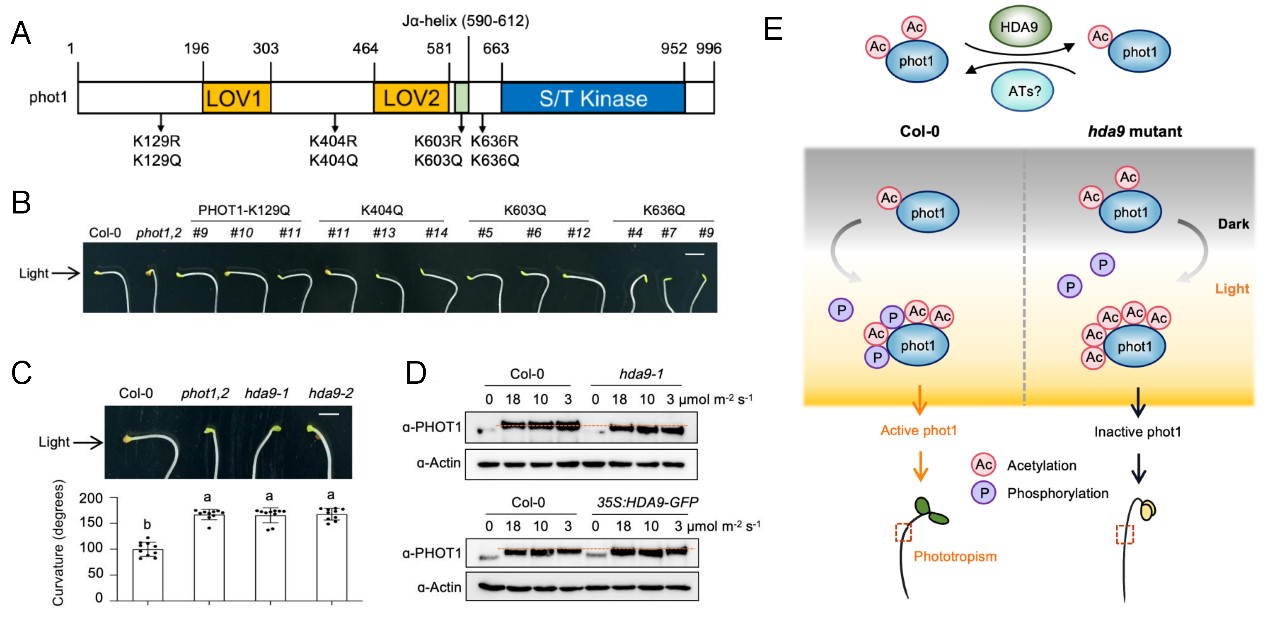Plant phototropism represents an essential adaptive mechanism that optimizes photosynthetic efficiency and developmental processes through directional growth responses to light. As the primary photoreceptor, phototropin 1 (phot1) mediates both blue light perception and subsequent phototropic responses in plants. While the molecular components and functional dynamics of phot1 downstream signaling pathways have been characterized, the upstream regulatory elements that modulate phot1 kinase activity in response to light signals remain unidentified.
The research team led by Xuncheng Liu at the South China Botanical Garden, Chinese Academy of Sciences, has identified acetylation modifications at multiple lysine sites of phot1 and confirmed that acetylation of a conserved lysine site (K636) regulates its auto-phosphorylation and kinase activity, thereby affecting plant phototropism. Genetic phenotype screening revealed that lysine deacetylase HDA9 is a crucial factor regulating plant phototropism and influencing the phosphorylation and kinase activity of phot1 by modulating the acetylation level. Additionally, this “acetylation-phosphorylation coordination regulation” has been shown to be highly conserved across different species such as tomato, tobacco, and peanut, highlighting the breadth and importance of this mechanism in plant phototropism signaling pathways.
Based on these findings, the research group proposes a molecular model linking acetylation modifications to light signal and phot1 activation: Upon perceiving environmental light signals, phot1 undergoes rapid phosphorylation, thereby activating its signal transduction function, while significantly reducing its binding capacity with HDA9. Subsequently, acetylated phot1 gradually accumulates under the action of unknown acetyltransferases (ATs), forming a negative feedback regulatory loop. This mechanism prevents excessive amplification of light signals by inhibiting excessive phosphorylation of phot1. This cyclical “acetylation-deacetylation modification” module constitutes a precise molecular braking system capable of fine-tuning the intensity of phototropism signal transduction, thus ensuring optimal growth responses in plants. This unique model demonstrates the high precision and plasticity of plant light signal transduction pathways. This study provides a new theoretical foundation for genetic breeding aimed at improving light adaptability and efficient light energy utilization in crops.
This study entitled “Histone Deacetylase 9 Modulates Phototropin 1 Acetylation Dynamics to Fine-Tune Phototropic Responses in Plants”, was recently published in Plant Communications (Impact factor2024: 11.6). Assistant Researcher Minting Liang and Researcher Shulin Deng are co-first authors, with Researcher Xuncheng Liu serving as the corresponding author. Other team members include Associate Researcher Yi Zhang and Zhiyang Lie, Dr. Guangyi Dai from the Public Laboratory, graduate student Yongyi Yang, and intern Jingyuan Guo. This research was supported by grants from the National Natural Science Foundation of China and the Guangdong Provincial Science and Technology Plan.
Paper link: https://www.sciencedirect.com/science/article/pii/S2590346225001865

Figure 1. HDA9 Mediates Phot1 Acetylation-Phosphorylation Homeostasis to Regulate Plant Phototropism.



